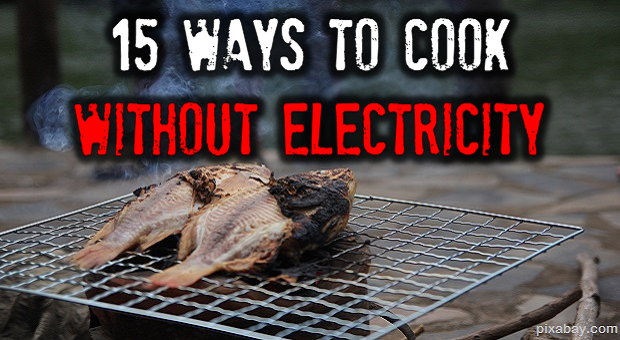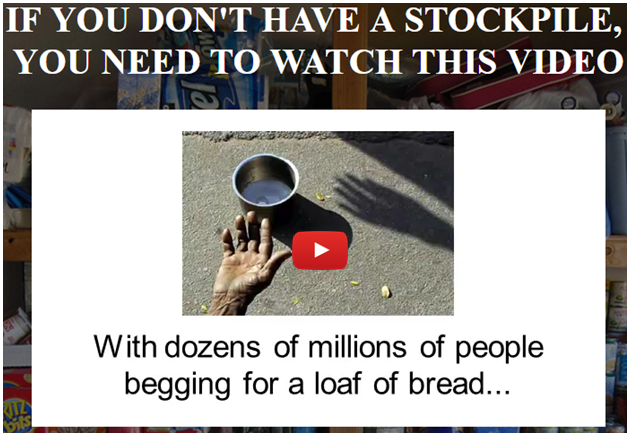When it comes to preparing for disaster, one of the first things that we need to do as preppers is determine how we’re going to cook food if SHTF. Nearly all stoves nowadays are electric so if the power goes out, you’re forced to find alternative cooking methods. For many, this will be a challenge, but not if you’re properly prepared.
If you’re fortunate enough to live in a warm climate or experience a disaster in the spring, summer or fall, cooking outside is an option. If, however, SHTF in the winter, you may not be able to go back and forth to a grill or a campfire. Also, solar heaters won’t be so great either, because the outside temperatures may be low enough to affect the cooking process. Let’s take a look at ways to cook both indoors and out without needing power.
Cooking Indoors Without Electricity
Even if it’s warm outside, it’s still more convenient to cook inside that it is to cook outside, unless of course it’s so hot that you don’t want to increase your indoor temperature by cooking inside.
If it’s winter, fall or spring, though, it may be nice to have the added warmth. Here are a few ways that you can cook your food inside.
1. Have a wood-burning stove
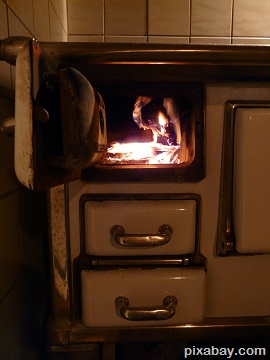 There are a couple of different types of wood-burning stoves that I’m referring to. The first is the old-timey cook stove. If you have one of these in the basement already ventilated and ready to go, then you’re all set. You can cook, you can bake and all you need is wood or coal.
There are a couple of different types of wood-burning stoves that I’m referring to. The first is the old-timey cook stove. If you have one of these in the basement already ventilated and ready to go, then you’re all set. You can cook, you can bake and all you need is wood or coal.
The second type of wood-burning stove that I’m talking about is the type that you use to keep warm. The tops of these get plenty hot enough to heat a skillet or a pot of water; you can most certainly cook anything that you’d like to on them. Again, all you need is wood or coal.
You need to be careful with these though; because they do get so hot, you can easily start a fire if the stove is too close to flammable objects such as curtains, or your apron!
2. Use a gas stove
Another alternative to electric ranges is a gas stove. Though this may not be an option for you if you live in an apartment or in a rented house, there’s no reason why you can’t have a gas stove that runs either on natural gas or on propane. Either will require significant changes to pipes and ventilation but it can certainly be done, especially if you’re building your own house from the ground up.
Be aware that if you use propane, you can only cook until your tank runs empty! Even natural gas may be an issue because gas lines may be damaged, rendering your stove useless.
3. Use your fireplace
Fireplaces are beautiful to look at on cold nights and they throw off a pleasant heat. If SHTF, you can also cook in a fireplace. Just treat it as you would a campfire: use grates to place your skillet on. You can also go totally old school and have a hanging cauldron for soups and such. You can also wrap some foods, such as potatoes or veggie packs, in aluminum foil and put it straight into the fire.
If you choose to use a fireplace, it’s imperative that you maintain it properly. Don’t use sappy woods that will build up in your chimney and start a fire. Also, don’t use soft woods for two reasons: first, they’re gofer wood. That means that as soon as you put a couple of pieces in, they’ll burn so fast you’ll need to gofer more. They also tend to have pockets of sap and water that will pop when the wood burns, causing a fire hazard. Don’t burn treated or painted wood, either.
Then what should you use? Well-seasoned hardwoods such as ash, maple, oak and hickory make great burning wood for both indoor and outdoor fires. The reason that it needs to be seasoned is so that the water has had a chance to dry from it. Unseasoned wood doesn’t burn too well.
4. Sterno stoves
Sterno stoves are stoves that run off of small jars of a gel substance that will burn for several hours but won’t spill out if you knock it over. Sterno stoves can be used indoors or out and get hot enough to heat water or cook some scrambled eggs or canned soup but they don’t put off enough heat to cook meats or quantities of anything.
5. Kerosene heaters
These were commonly used for decades as a means to heat rooms when the weather got really cold. Though they are dangerous if you’re not careful, they’re still good for that. The tops of them also get hot enough that you can heat soups, canned vegetables and water for coffee or sponge-bathing.
6. Folding stove
This is a cool little contraption that folds down flat but opens up to hold a sterno can. It doesn’t get extremely hot but will warm up soup or water. The advantage to a folding stove is that it folds down into practically nothing, making a great addition to your bug out bag or your car emergency kit.
7. Butane stoves
These are compact stoves that run off of butane. They’re a bit bigger than a laptop and are great for short-term cooking. The only downside here is that the butane can be really expensive so it’s only feasible for short-term cooking in small spaces. There are better options because of cost, but a butane stove gets hot enough to cook whatever you want as long as you’re willing to spend the money on the fuel.
Outdoor Cooking
Cooking outdoors gives you several more options than cooking indoors. You don’t have to worry about smoke, noxious fumes or burning your house down. There are many ways to cook outdoors as long as the weather is good and you won’t freeze to death making a dash for your heating source. Keep in mind that you also want your house to stay warm. Opening and closing the door a dozen times to cook outside isn’t a great way to do that.
1. Grills
Nearly all of us own at least one small grill. Though yours may be gas, it’s ok; once you run out of gas, simply use it as a wood or charcoal grill. It may mess things up a bit with your grill but it beats starving to death. Also, a grill has the advantage of a lid so that you’re trapping more heat inside of it. As a result, your food will cook faster and more evenly.
2. Camp stoves
These handy little camping stoves run off of bottled gas and can be a lifesaver as long as you’re either cooking short-term on it or have a ton of back-up bottles of gas. No matter how tempted you may be DO NOT use them inside!
3. Open fires
Cooking on an outdoor fire is probably something that all of us have done at one time or another. To build a good cooking pit, use blocks or stone stacked at least 2 feet from the ground. Dig a pit in it another foot or so deep so that you have plenty of room to get good heat but not get your skillet so hot that your food will burn. Then just set a grate over it and cook your heart out.
Iron skillets are an awesome asset to have for this purpose because they won’t catch on fire and they distribute the heat more evenly over the bottom and sides of the skillet. Dutch ovens are great for outdoor cooking over a fire, too. You can make biscuits, cakes and all kinds of soups in them. If you really want to go all-out, get the tripod to hang it from over the fire. You can also set the Dutch oven down in the coals and even cover it with coals to cook what’s inside.
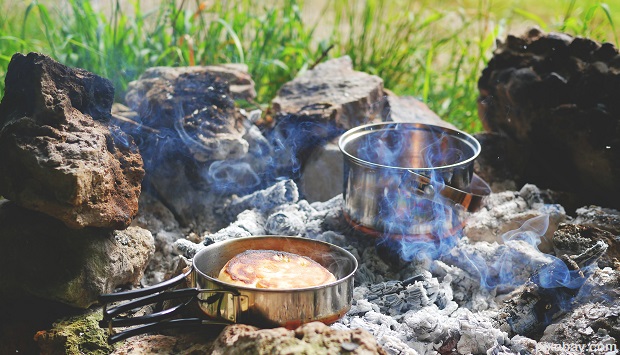
4. Solar ovens
Solar ovens are functional when it’s warm and clear out. They cook using only the power of the sun and very few have any kind of backup storage so if it’s cold or overcast outside, they aren’t going to do you much good. You can actually build your own solar oven, which I believe we’ve covered in another article.
5. Rocket stoves
Rocket stoves are compact, efficient stoves that use small pieces of wood in a high-temperature combustion chamber. You put the wood in (you need small pieces), light it, then the heat travels up a chamber and out the top. They’re extremely effective for cooking single batches of food at a time. Since they use small pieces of wood extremely efficiently, they’ll save your wood supply while rapidly cooking your food.
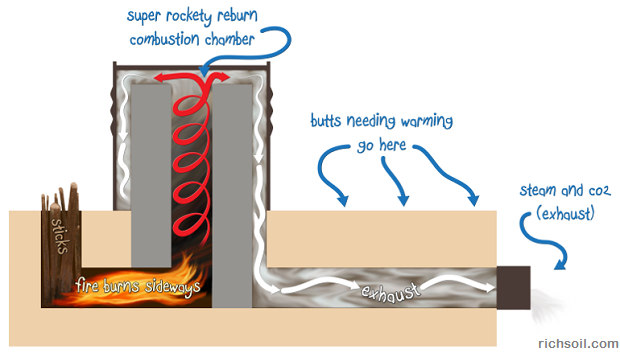
6. EcoZoom
An EcoZoom is a relatively new addition to the rocket stove family. Though it functions in basically the same manner as a standard rocket stove, it’s built to burn wood, dried biomass such as plants or animal waste, or charcoal. It comes with a rack for the charcoal. It also comes with a pot skirt that seals the area between the pot and the heating chamber so that you lose very little heat. Supposedly it uses 25 percent less fuel that way.
Even without the cooking skirt, the EcoZoom requires very little fuel to create plenty of heat. You need only a few pieces of wood or 5 or 6 charcoal briquettes.
7. Volcano stove
A volcano stove is a collapsible stove that is extremely portable while being incredibly functional and versatile. You can use wood, charcoal or propane as your heat source and you can heat relatively large amounts of food with it.
It’s plenty hot enough to cook on and its portability makes it a top-notch tool for the prepper on the go. It folds right into itself and is fairly lightweight. They’re cheaper than most gas grills by a long shot and, since they use alternate heat sources, they’re more practical than a camp stove.
8. Use your car motor
If you’re completely out of options and all you have is food that needs to be cooked, you can always use the heat of your car’s motor to cook. Make sure that your garage is cracked so that you don’t die of carbon monoxide poisoning, then wrap potatoes, small cuts of meat, etc. in aluminum foil and stick it down around your motor after letting your car run long enough to get warm.
Consider though that cooking on your car motor is an awkward way of cooking and uses fuel that you may need later. It’s a last ditch option, but it’s possible.
Remember when you’re cooking that the smell of smoke and food cooking travels for miles. If you’re trying to stay hidden, you may want to limit your cooking to an indoor room or cook all of your food in the middle of the night when most people are sleeping. The last thing that you want in a survival situation is hundreds of hungry people converging upon you because they smelled your food.
If that should ever become the case, stick with small fires and foods such as soup that don’t have much of a smell when cooking. Cook small if you’re trying to hide or simply eat your food cold. You can also use caves or cliff walls to buffer the smell somewhat or you can cook in an area with dense tree coverage that will dissipate some of the smoke and smell.
The world may very well become a dangerous place so consider all of this before you build a bonfire and start roasting the last of your marshmallows. You don’t want the entire city full of people who didn’t prepare to realize that you’re a source of food and all things good because once they figure it out, you’ll have a fight on your hands.
If you’re just experiencing a brief power outage, this isn’t an issue, but if something big does happen, just be aware of the dangers. Happy cooking!
If you have any other suggestions or comments to add about alternative cooking sources without electricity, please share them with us in the comments section below.

